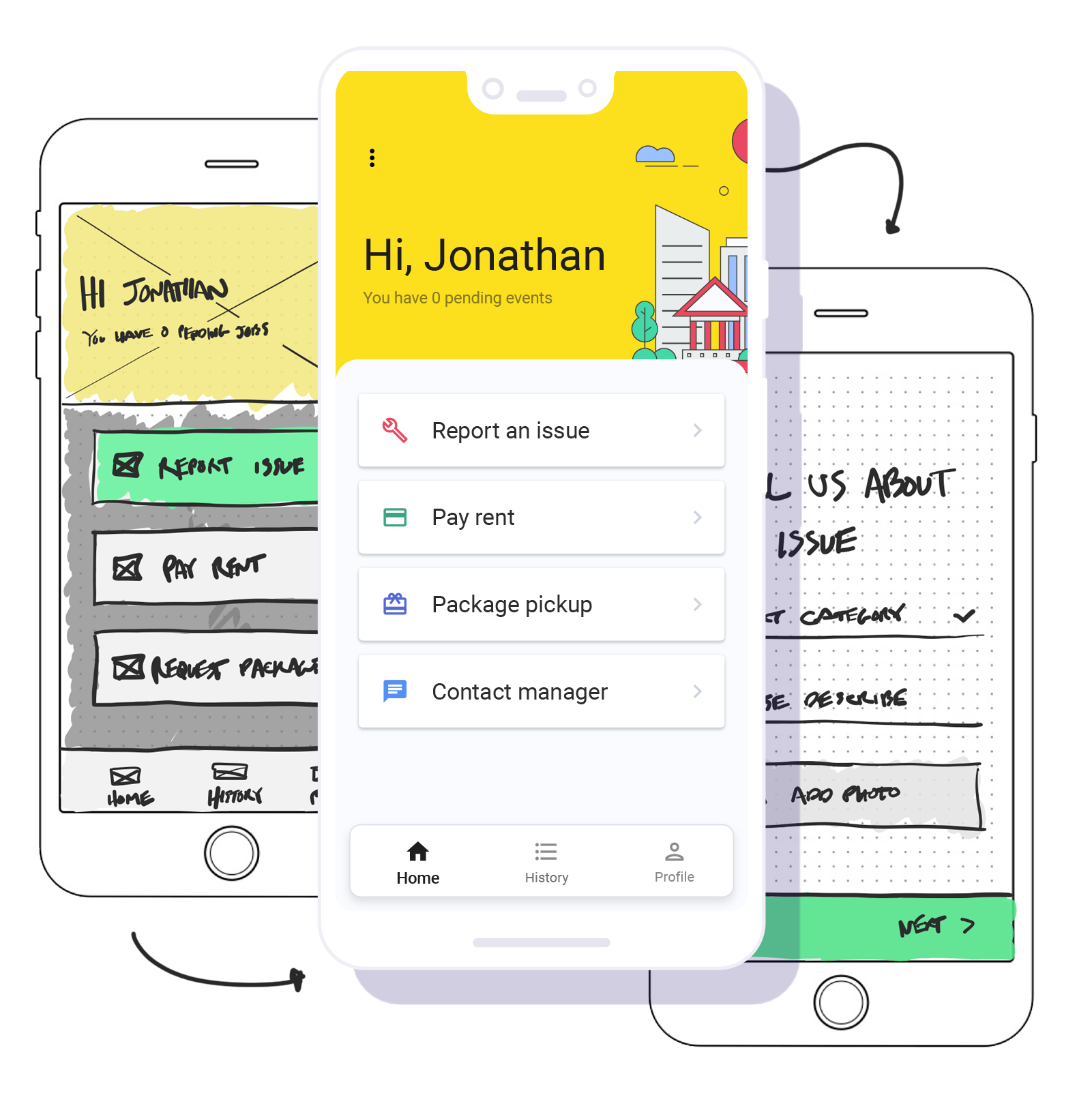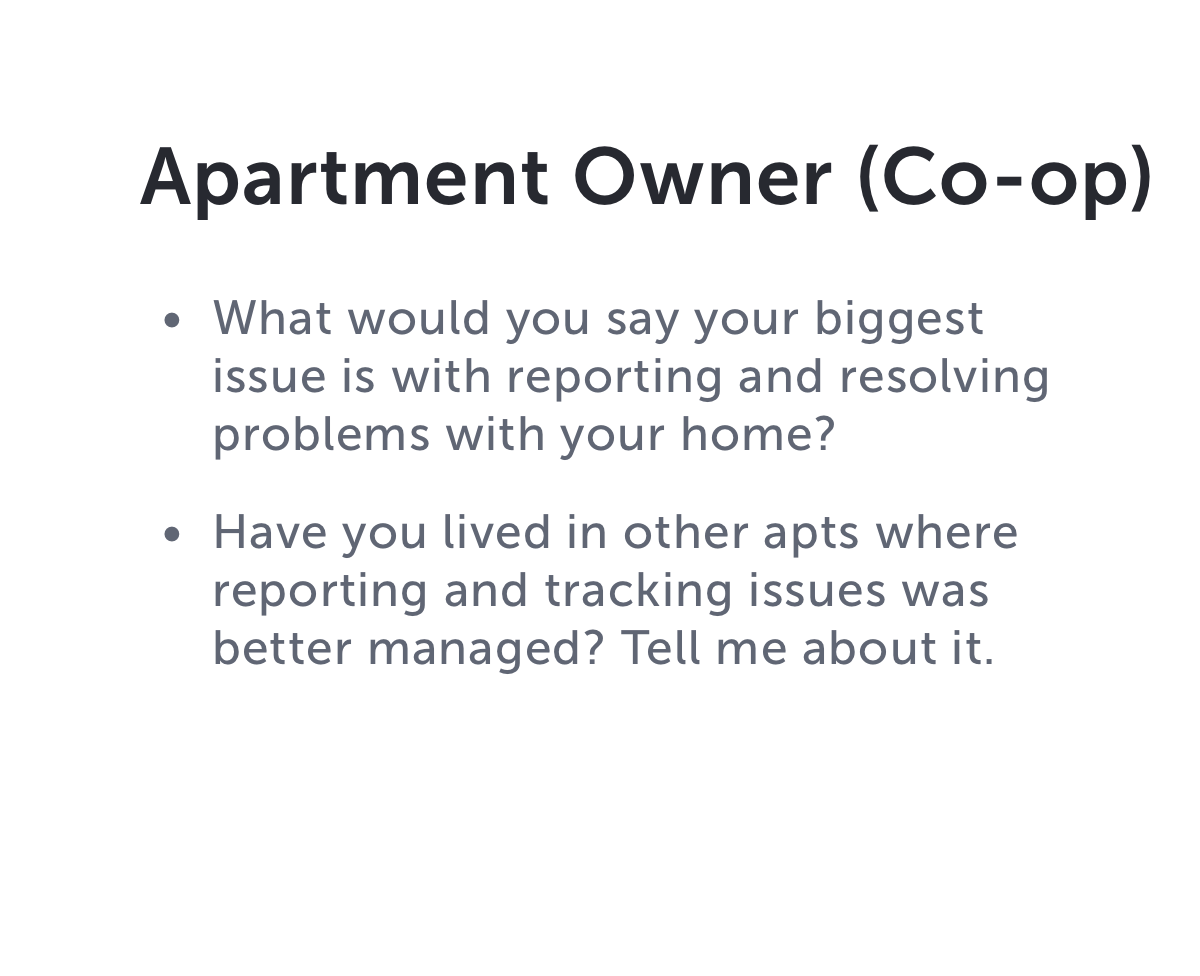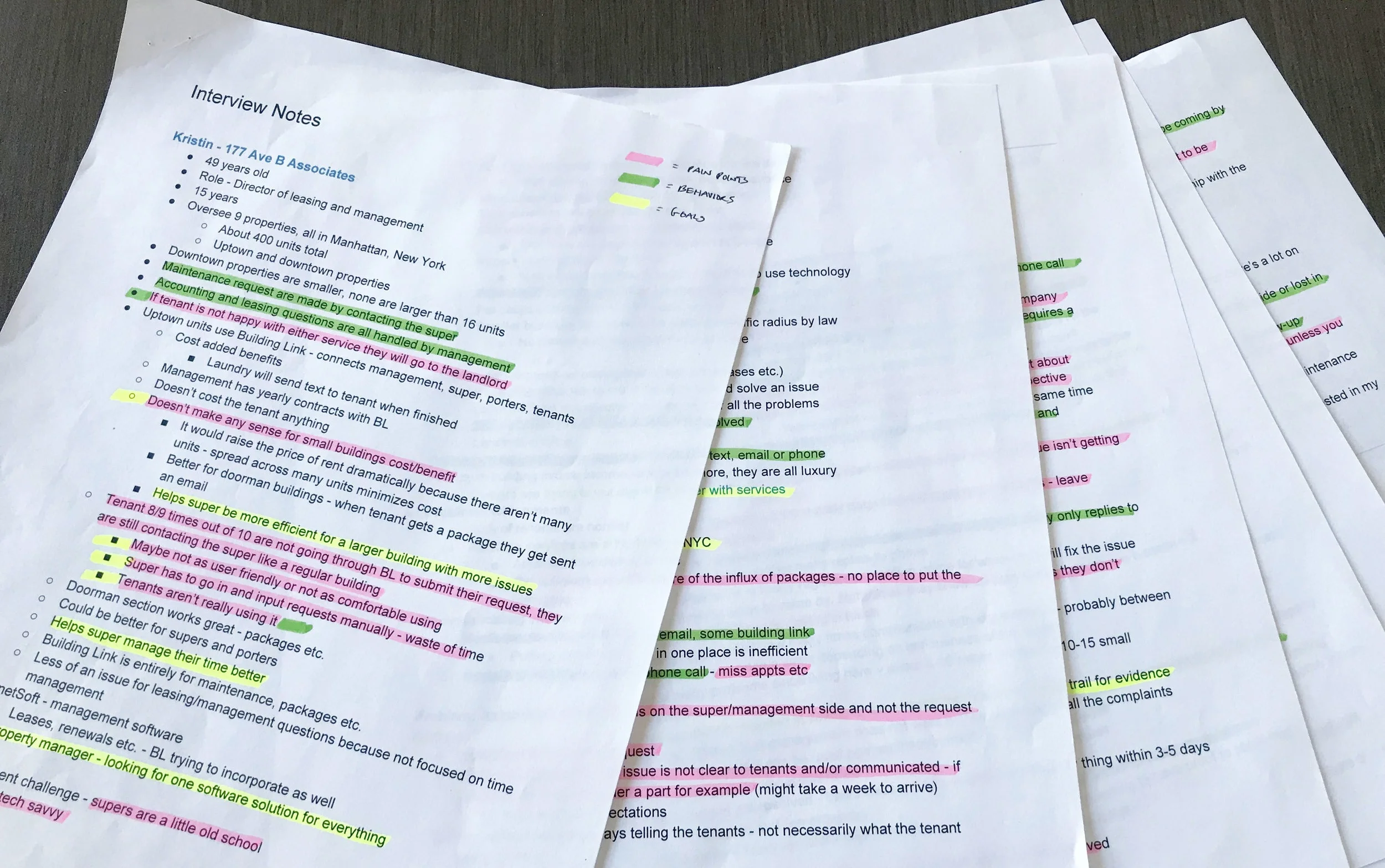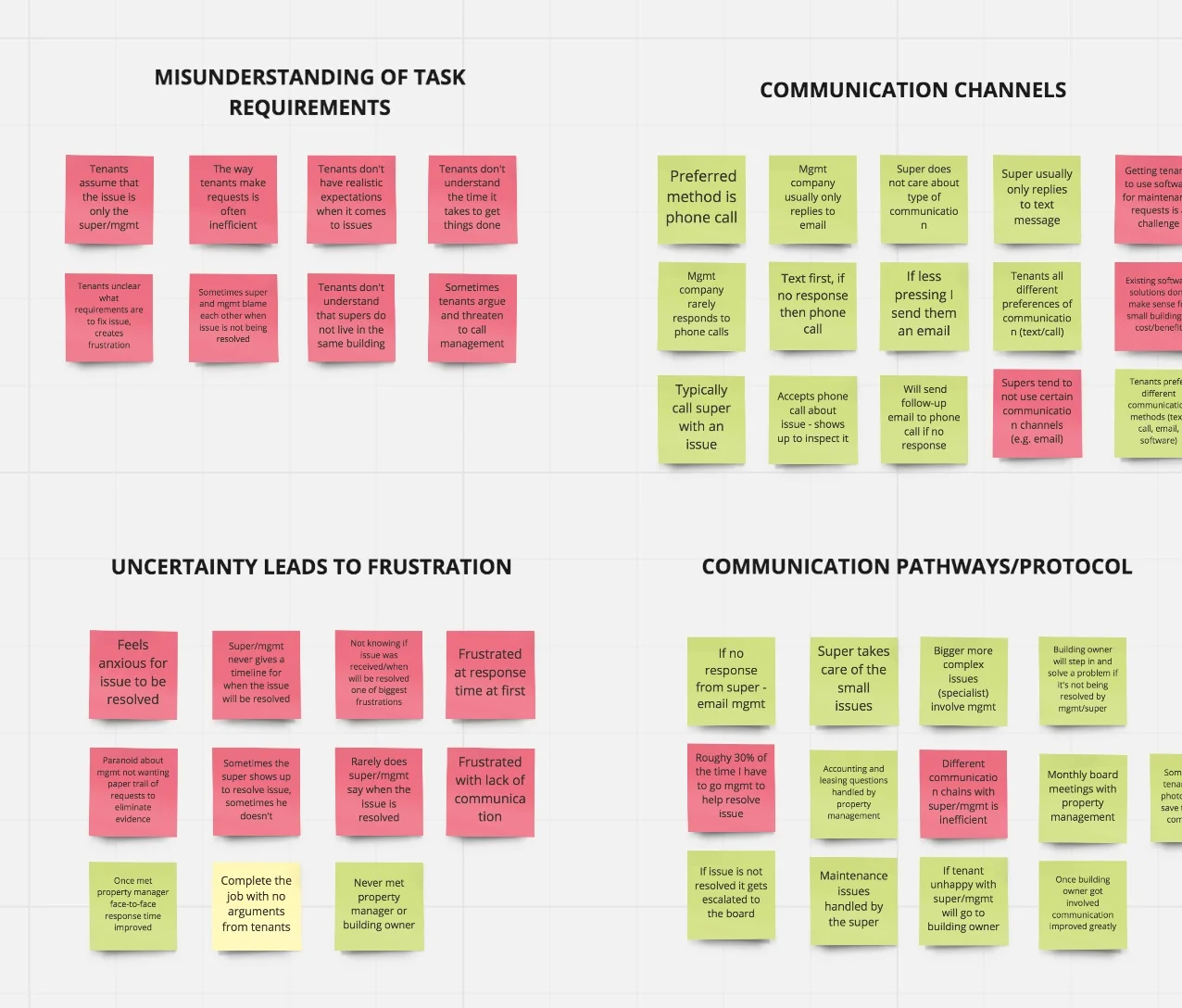homr
A tool for tenants and property managers to improve reporting, tracking and resolution of maintenance issues in order to create peace of mind, build trust and improve the overall renter’s experience.
Overview
A great residential community (e.g. condominium, college dormitory, etc.) provides a variety of amenities and a dedicated staff responsible for its maintenance. But there isn’t always an easy way for community members to report problems to management so they can be resolved quickly. I was tasked with designing a system for a community of my choice, so members can report issues and track their resolutions.
My role
User research
User interviews
Journey Mapping
Sketching
Wireframing
Screen Flows
Visual Design
Interaction Design
Company
Google (design challenge)
Duration
Jan 1 - Jan 16
1 - RESEARCH
Who are the users?
Due to scope constraints I decided to investigate users in an environment where I had access to rich and relevant qualitative data: apartment residences in an urban area. I started there and set out to further define who the users are and learn more about how they report, track and resolve maintenance issues and what their needs, behaviors and pain points are.
I conducted four interviews in total. Here’s who I interviewed and some question examples:
Transcribed notes with color coding
Documentation and affinity mapping with RealTimeBoard
After learning more about different groups of users (super, owner) and environments (co-op, rental), I decided to focus on the following users in the environment of small, non-luxury apartment buildings in an urban area.*
Key insights
Tenants lack of knowledge of issue reporting and resolution creates unrealistic expectations, anxiety and frustration
Very few incentives for supers to provide good service other than complaints to management or building owner
Varying preferences and severity of issue creates inconsistency in communication channels
Tenants are often irrational and overly sensitive during issue resolution process
What is the journey?
After learning more about the behavior, pain points and goals of each user group, I mapped out a piece of the tenant journey to get a better sense of a timeline for discovering, reporting, tracking and resolving an issue. If I had more time I would potentially do a similar exercise for other user groups.
One thing that stuck out was the ‘feelings’ swim lane, which was filled with negative feelings and uncertainty throughout the entire issue resolution process.
What are the problems?
The research conducted thus far gave me a clearer interpretation of the problem related to resolving maintenance issues for all three user groups:
Tenants
Tenants are not provided with enough information about how to best report a maintenance issue, what is required to solve the problem and how long it will take to be resolved. This uncertainty leads to a poor, distrustful tenant/landlord relationship and an uncomfortable living experience.
Supers
Tenants do not have a clear understanding of how to best report a maintenance issue, what is required to solve the problem and how long it will take to be resolved with the constraints of a busy superintendent schedule. This leads to frustration on both sides and a difficult work environment.
Property Managers
Property managers do not have a cost effective tool for reporting maintenance issues for luxury and non-luxury properties that supers will adopt in order to save time and streamline communication.
How might we…
Provide tenants with more information about reporting maintenance issues, what is required to solve the problem and how long it will take to be resolved so that they can have peace of mind and build trust with management.
What else is out there?
Before designing a solution I did some brief searching to find out what already exists in the market today.
This was helpful to understand how products in the market are addressing the problem of maintenance resolution and many other friction points in the tenant, property management relationship. Nearly all the software products I found provided solutions that fell into one or all of the following buckets:
Leasing services
Rental marketing
Websites
Tenant screening
Application tracking
Management tools
Maintenance and repairs
Package tracking
Lease management
Management Analytics
Employee Attendance
Accounting tools
Online rent and financials
Property accounting
Financial reporting
Company financials
2 - CONCEPT
For the proposed solution I aimed to address the problems and needs of each user group in a creative way. Below I break down how it works at a high level, components of the product that relate to each user group, experience/sit flows and initial wireframes.
Tenants
Detailed Reporting - Includes category of the issue, brief description, photos and urgency. This data is used to better match a specialist and reduce the need for back-and-forth communication.
SMS Messaging & Automation - Includes updates when specialist has accepted, when they are on their way, when parts are needed and upon completion. This increases awareness and expectation while reducing uncertainty and anxiety.
Rating/Incentive System - Includes ratings of specialist and job upon completion. This incentivizes specialists and provides useful data for property managers for future jobs.
Property Managers
Specialists Not Supers - Replacing the Super user group with pre-vetted specialists provided by HOMR. While this adds adds cost and risk, this assures adoption, better tenant experience and time saved.
Machine Learning - Data inputs from reporting, rating, and more to predict when a job will be complete and match more effectively with a specialist.
Supers –> Specialists
My thinking was regardless how effective the software solution, Super adoption will always be an issue. Replacing them with outsourced specialist minimizes this problem as well as others big problems related to the tenant experience. While this solution is essentially replacing this user group, perhaps there are versions that include Super adoption.
Experience map
Wireframes
Due to the fact that much of this solution involves text messaging. I chose to wire out two of the flows for tenants reporting an issue and a specialist receiving and accepting the job. I also kept in mind that I’d be utilizing Google’s Material Design system so I felt ok about starting with rough sketching and jumping to high fidelity mockups.
Risks. Challenges. Questions.
Outsourcing maintenance is higher risk and higher cost
How will specialists handle larger jobs (e.g. fixing an elevator)?
Making this cost-effective to justify use for smaller buildings will be difficult
What if management wants to use this solution with more tech-savvy supers?
How does this work towards mgmt goal of one source solution?
3 - VISUAL DESIGN
Because this is a B2C as well as a B2B product, I wanted to have fun with brand and the emotional side of design. Focusing on the tenant UI, I briefly compiled a mood board with images, color, typography and feelings related to this designed solution.
For the UI I started with some Material Design system components but augmented them in certain situations. For the final deliverables I focused on the flow of a tenant reporting an issue.
Home screen
While the only designed flow for this project is “Reporting an Issue” I did think about other key actions tenants could take and use the home screen as a jumping off point.
Bottom nav - only visible from the home screen. Tenant can view all logged events (reported issues, paid rent) in the history tab and view building and leas details in profile
Professional/Playful - I tried to evoke professionalism and reliability yet approachable and playful with illustration and color
Aligning with Google:
Bright bold colors
Material components
Simplicity
New components and interactions:
Multi-select tiles
Large floating CTA
Limited UI + Automation
Most of the user interaction happens via SMS message with automatic updates and high-touch communication with a specialist. While every interaction is documented in the application.
Utilizing Geo-location
Keeping in mind the sensitivity of the tenant, we use geolocation to automatically notify the user when a specialist is on their way and arrive to inspect or resolve an issue, so they are aware when someone is in their home.
RETROSPECTIVE
What went well
Clear goals - good job outlining exercise based on strengths I wish to highlight
Thorough discovery/design - I believe my detail oriented process shines through in each phase of research, concept/solution, visual design
Presentation - outline based on goals, lots of visual documentation
What I can improve on
Scope creep - while aware of time throughout my process, sticking to my initial proposed scope was tough
Simplify - while very thorough, I can work on being more succinct and being creative with stricter constraints
If I had more time…
More research
Interviews (tenants, super, mgmt, building owner)
Investigate different community environments (luxury building, condominiums)
Research and categorize “issues”
Full journey map (tenant, super, mgmt)
Concept
Build out full prototype
Craft conversation tree
Test/Validate
Implementation plan





























